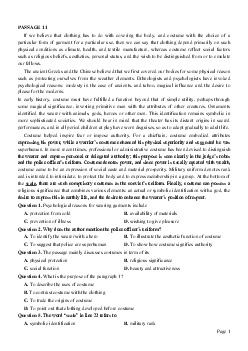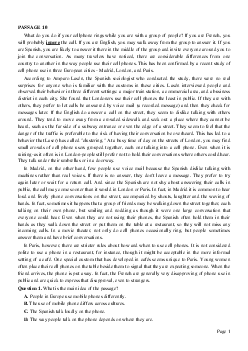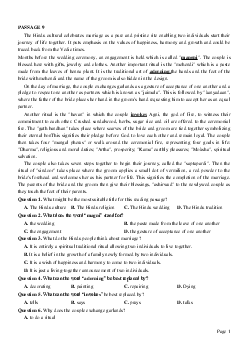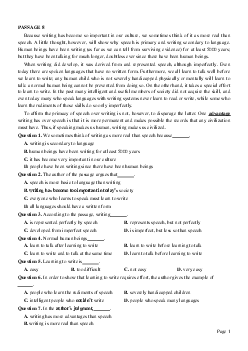


Preview text:
PASSAGE 8
Read the following passage on transport, and mark the letter A, B, C, or D on your answer sheet to
indicate the correct answer to each of the questions from 1 to 8.
Quite different from storm surges are the giant sea waves called tsunamis, which derive their name from
the Japanese expression for “high water in a harbor.” These waves are also referred to by the general
public as tidal waves, although they have relatively little to do with tides. Scientists often referred to them
as seismic sea waves, far more appropriate in that they do result from undersea seismic activity.
Tsunamis are caused when the sea bottom suddenly moves, during an underwater earthquake or volcano
for example, and the water above the moving earth is suddenly displaced. This sudden shift of water sets
off a series of waves. These waves can travel great distances at speeds close to 700 kilometers per hour.
In the open ocean, tsunamis have little noticeable amplitude, often no more than one or two meters. It is
when they hit the shallow waters near the coast that they increase in height, possibly up to 40 meters.
Tsunamis often occur in the Pacific because the Pacific is an area of heavy seismic activity. Two areas of
the Pacific well accustomed to the threat of tsunamis are Japan and Hawaii. Because the seismic activity
that causes tsunamis in Japan often occurs on the ocean bottom quite close to the islands, the tsunamis
that hit Japan often come with little warning and can, therefore, prove disastrous. Most of the tsunamis
that hit the Hawaiian Islands, however, originate thousands of miles away near the coast of Alaska, so
these tsunamis have a much greater distance to travel and the inhabitants of Hawaii generally have time
for warning of their imminent arrival.
Tsunamis are certainly not limited to Japan and Hawaii. In 1755, Europe experienced a calamitous
tsunami, when movement along the fault lines near the Azores caused a massive tsunami to sweep onto
the Portuguese coast and flood the heavily populated area around Lisbon. The greatest tsunami on record
occurred on the other side of the world in 1883 when the Krakatoa volcano underwent a massive
explosion, sending waves more than 30 meters high onto nearby Indonesian islands; the tsunami from this
volcano actually traveled around the world and was witnessed as far away as the English Channel.
Question 1. The paragraph preceding this passage most probably discusses . A. tides
B. underwater earthquakes C. storm surges D. tidal waves
Question 2. According to the passage, all of the following are true about tidal waves except that .
A. they are the same as tsunamis
B. they refer to the same phenomenon as seismic sea waves
C. they are caused by sudden changes in high and low tides
D. this terminology is not used by the scientific community
Question 3. The word “displaced” in line 6 is closet in meaning to . A. located B. moved C. filtered D. not pleased
Question 4. It can be inferred from the passage that tsunamis .
A. are often identified by ships on the ocean
B. are far more dangerous on the coast than in the open ocean
C. causes serve damage in the middle if the ocean
D. generally reach heights greater than 40 meters Page 1
Question 5. In line 9, water that is “shallow” is NOT . A. coastal B. tidal C. clear D. deep
Question 6. A main difference between tsunamis in Japan and in Hawaii is that tsunamis in Japan are more likely to .
A. arrive without warning B. originate in Alaska
C. be less of a problem
D. come from greater distances
Question 7. The possessive “their” in line 15 refers to . A. these tsunamis B. thousands of miles
C. the inhabitants of Hawaii D. the Hawaii Islands
Question 8. The passage suggests that the tsunamis resulting from the Krakatoa volcano .
A. resulted in little damage
B. caused volcanic explosions in the English Channel
C. actually traveled around the world
D. was unobserved outside of the Indonesian islands ĐÁP ÁN 1-C 2-C 3-B 4-B 5-D 6-A 7-A 8-C
LỜI GIẢI CHI TIẾT Question 1: C
Với dạng câu này ta đọc câu đầu của đoạn văn vì câu này sẽ là câu dẫn với đoạn văn trước đó: “Quite
different from storm surges are the giant sea waves called tsunamis, which derive their name from the
Japanese expression for “high water in a harbor.”Khác với những cơn song dâng cao do bão gây ra đó là
những đợt sóng biển lớn được gọi là tsunamis, từ này được xuất phát từ cụm từ tiếng Nhật “nước dâng
cao ở một cảng” Vậy đáp án là storm surges vì câu này so sánh với storm surge trong đoạn văn trước đoạn văn này Question 2: C
Chúng ta scan từ tidal waves để tìm ra đáp án là C. they are caused by sudden changes in high and low
tides (chúng được gây ra bởi sự thay đổi đột ngột của thuỷ triều lên và xuống. Ở dòng 2 +3 đoạn 1 có
nhắc tới “These waves are also referred to by the general public as tidal waves, although they have
relatively little to do with tides” Người dân xem những con sóng này như là những con sóng thuỷ triều
mặc dù chúng gần như không liên quan đến thuỷ triều.
Phương án A được tìm thấy ở dòng 1 +2 + 3 đoạn 1: “Quite different from storm surges are the giant sea
waves called tsunamis, which derive their name from the Japanese expression for “high water in a
harbor.” These waves are also referred to by the general public as tidal waves” Những con sóng này cũng chính là tsunamis
Phương án B và D được tìm thấy ở dòng 3 đoan 1: “Scientists often referred to them as seismic sea
waves, far more appropriate in that they do result from undersea seismic activity” Các nhà khoa học Page 2
thường đề cập đến chúng như là các cơn sóng biển địa chấn, thuật ngữ này phù hợp hơn vì chúng được
gây nên bởi hoạt động địa chấn dưới biển. Question 3: B
Displace ≈ move: dịch chuyển
Các phương án khác là: located: nằm ở, filtered: lọc, not pleased: không thoải mái Question 4: B
Đáp án nằm ở dòng 4 +5 đoạn 2: “In the open ocean, tsunamis have little noticeable amplitude, often no
more than one or two meters. It is when they hit the shallow waters near the coast that they increase in
height, possibly up to 40 meters.” Ở ngoài đại dương, sóng thần không có ảnh hưởng gì đáng chú ý,
thường không cao quá 1 hay 2m. Chỉ khi sóng đánh vào dòng nước nông gần bờ biển dâng cao có thể lên
đến 40m. Nên suy ra là sóng thần nguy hiểm hơn rất nhiều ở bờ biển so với ở ngoài đại dương. Question 5: D
Shallow = not deep: nông, không sâu
Các phương án khác là: coastal: thuộc về bờ biển, tidal: thuỷ triều, clear: rõ ràng Question 6: A
Đáp án ở dòng 3 + 4 đoạn 3: “the tsunamis that hit Japan often come with little warning and can,
therefore, prove disastrous” Sóng thần đánh vào Nhật Bản thường đến mà không có cảnh báo trước và do
đó có thể gây ra thảm hoạ.
Trong khi đó sóng thần ở Hawaii: “Most of the tsunamis that hit the Hawaiian Islands, however, originate
thousands of miles away near the coast of Alaska, so these tsunamis have a much greater distance to
travel and the inhabitants of Hawaii generally have time for warning of their imminent arrival” Tuy
nhiên hầu hết các sóng thần đánh vào Hawaii bắt nguồn từ ngoài biển cách xa ngàn dặm so với bờ biển
Alaska, vì vậy những cơn sóng thần này cần phải đi qua một chặng đường dài mới đánh vào đất liền và
người dân ở Hawaii nhìn chung có thời gian cảnh báo về cơn sóng thần sắp đến. Question 7: A
Their ở đây là đề cập đến các cơn sóng thần. “Most of the tsunamis that hit the Hawaiian Islands,
however, originate thousands of miles away near the coast of Alaska, so these tsunamis have a much
greater distance to travel and the inhabitants of Hawaii generally have time for warning of their
imminent arrival” Tuy nhiên hầu hết các sóng thần đánh vào Hawaii bắt nguồn từ ngoài biển cách xa
ngàn dặm so với bờ biển Alaska, vì vậy những cơn sóng thần này cần phải đi qua một chặng đường dài
mới đánh vào đất liền và người dân ở Hawaii nhìn chung có thời gian cảnh báo về cơn sóng thần sắp đến. Question 8: C
Đáp án ở dòng 5 đoạn 4: “the tsunami from this volcano actually traveled around the world” Page 3




